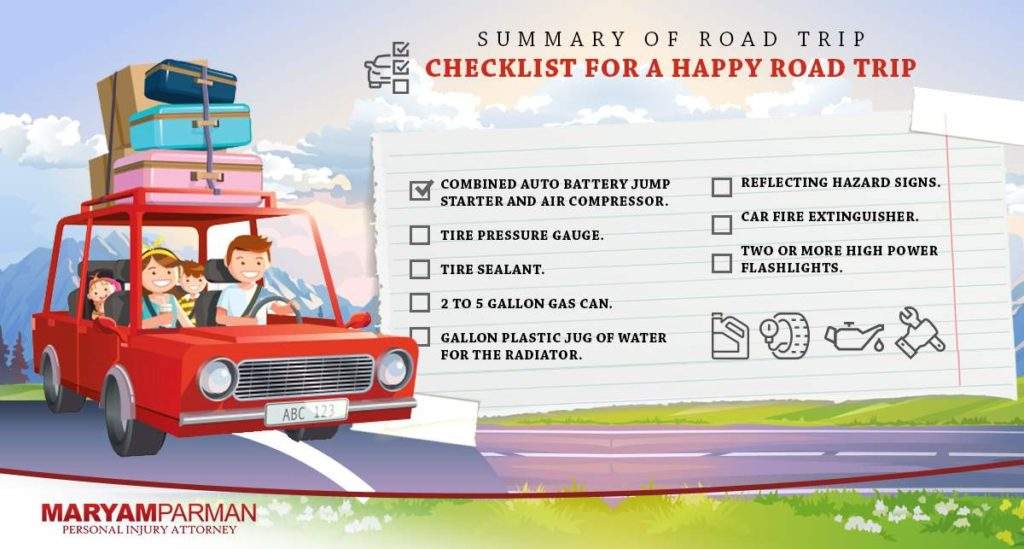Across the country, college kids are planning their spring break travel, with most heading for the sun. Many parents look at college road trips as a rite of passage, but all of us worry about our kids’ safety.
With all the gear that generally ends up in the road trip car, it’s hard to find room for the passengers. But no matter how much your kids scream and moan about taking safety equipment, you should prepare the travel car for the four most common emergency road service problems: Flat tires, dead batteries, running out of gas, and engine overheating. If you properly equip your son or daughter to deal with these problems, you will create a very useful car emergency kit and teach your young adult more about road safety.
In Every Roadside Emergency, Put Reflecting Hazard Triangles on the Road
Reflective hazard signs should be standard issue tools for cars because the first order of auto road service is to protect the driver and the passengers. Flashing hazard lights are good, but sometimes other drivers don’t spot the flashing lights until they are too close to the stopped vehicle. Especially during the day, flashing lights are hard to see.
The highway safety board suggests that three hazard signs be put behind the car: One about 25 feet back from your car, and as far out towards the middle of the road to mark the outer edge of your car. The second should be back around 100 feet and closer to the edge of the road. The third should be back around 200 feet back at the edge of the highway. As you walk back to place these signs, assemble one and hold the reflecting surface away so that oncoming cars can see you.
A Portable Car Battery Charger Jump Starts a Car in a Few Minutes
Dead batteries happen. And rarely when it’s convenient. There are three ways to get power back to their car.
The first way is the fastest and easiest: Use a portable car battery charger. Ideally, there is a charger stored in the car. Just attach it to the battery terminals, positive to positive and negative to negative, turn the charger on and restart the car. No fuss, no muss and about 10 minutes of time.
Second, the driver can flag down another car and use the heavy-duty jumper cables stored in the trunk to jump-start the battery. The cables should be at least 20 feet long to stretch from car engine to car engine. In theory, that is simple. But, it requires flagging down another car willing to help. Not easy on a rainy or snowy night. And it adds another layer of possible danger because who knows if the driver that will stop is really stopping to help
There is a 3rd option, which is to use the emergency service plan from a reputable organization, such as automobile association of America, to cover the trip. A simple phone call with the membership number handy gets help dispatched as soon as possible. Hopefully, the service is near the breakdown, and the service can find it. The roadside assistance services are very reliable but sometimes can take up to an hour or more for the service truck to arrive.
If there’s a portable battery charger in the car, the situation would be solved before the phone call roadside assistance is finished. They are not very expensive, and the right ones are also very helpful in solving the next most common problem – flat tires.
Flat Tire Repair Kit Is a Must, Especially When There’s No Spare
No doubt you taught your son or daughter how to fix as flat. In addition to being a real annoyance, generally, a flat tire is not life-threatening, unless it is a blowout, which can lead to a fatal accident. However, a flat tire can be fatal if you don’t take the proper precautions in repairing it. Most portable battery jump starters have a built-in air compressor, which makes them a wonderful 2-in-1 device. Puncture where air leaks out slowly, improper inflating
When changing a tire, put safety first! You have to be able to pull off the road, and it is best to do it so that you have the car between you and traffic. No flat tire is worth your life. Second, put out the reflecting hazard signs.
If your kid thinks that there is a puncture or a small slash, then a good solution is to use a tire sealant to plug the leak. The best of these are injected into the tire before the tire is re-inflated and will seal punctures up to an of an inch.
If it’s safe to do so, your travelers can change the flat tire for a spare. Just remember that before the start of the trip you should check the inflation of your spare tire. Most people, including me, are terrible about this. To do this, you need a good tire gauge.
Once the hazard signs are in position and the car is between you and traffic, hook up the portable air compressor. If you didn’t give your kid one of these for the trip, now is the time to get the spare tire and jack out of the truck. Have them make sure the jack is properly connected to the car, and it has a firm “seat” on the ground. You can get severely injured if the car falls on you.
If the car has one of the minuscule “spare” tires and you have a way to go to reach your destination, it might be smarter to repair the flat as described above.
Out of Gas Should Not Mean out of Luck
This one is easy to avoid. Just teach your kids to refill the tank when it gets down to a ¼ of a tank. If they forget and the tank hits empty, they will be very glad to have an extra tank in the car. Safety first! You were smart enough to give them a D.O.T. Approved metal, type in a container, the type that can be stored in a car trunk. If you don’t want to spring for a type iI container, then they can put a couple of plastic 1-gallon empty water jugs in the trunk and walk to the nearest gas station and bring it back. Better to buy the can!
When they fill the gas can before they start the trip, they should add a fuel stabilizer. This will keep the gas fresh for about a year and protect the car’s engine when this gas is put into the tank.
Engine Overheating Is like You Being Dehydrated
The driver should keep an eye on your temperature gauge. If the gauge shows overheating, or you see steam coming out from under the hood, you are in trouble. Not life threatening, but quite inconvenient. There are normally two reasons. The radiator doesn’t have enough water because of either a leak or just evaporation over time. Your kid should have a gallon jug of filtered or distilled water in your trunk. Once the radiator has cooled down, they should use a glove or an insulting cloth to remove the top.
They should stand back in case the radiator erupts and sprays super-hot water. Gradually add the extra water until it reaches the top. Give it a couple of minutes to settle in and check to see if more water is needed. Put the cap back on. Check the fan belt to make certain that is working properly to power the fan. If the fan belt is not working properly go to the nearest auto repair shop and get the fan belt fixed.
A Car Fire Extinguisher Saves Lives
When a fire starts, get off the road and get everyone out and well away from the car so that they are safe if the gas tank explodes. If the fire has just started and is well away from the gas tank, you may want to attempt to put it out. If so, you want a fire extinguisher using dry chemicals so that it is safe to use around electrical current.
High Power Flashlights
There are two types of flashlights that are useful around cars. You will need one or more high power flashlights for signaling and illuminating the work area. Get one with a beam distance of at least 500 feet. The second type is a head-mounted flashlight so that your kid can keep his hands free while working, And the light focused where they are looking.
Following this guide will your kid surely have most of the stuff they need to deal with the most common road emergencies. You, too, will feel a bit better about the trip.
Did your children have any trouble on the road? Do you need legal help? Give us a call!


